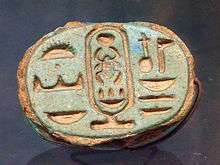Hill-country (hieroglyph)
| ||
| 3-Hills " hilly-country " in hieroglyphs |
|---|
The ancient Egyptian hill-country hieroglyph is a member of the sky, earth, and water hieroglyphs. A form of the hieroglyph in color, has a green line-(banding) at the base of the hieroglyph. The hieroglyph refers to the hills, and mountains, on both sides of the Nile River, and thus the green references the verdant black farming land adjacent to the river proper.
Various colors, and patterning,[1] may adorn the rest of the hieroglyph when the bottom is green.
Three major uses
ny.gif)
The ancient language hilly land hieroglyph has three major uses:
- 1 – hill country, or hills
- 2 – a reference to arid, desert land
- 3 – Determinative, for foreign lands
The language meaning of the hieroglyph is as an idiogram or a determinative in the word khast (khaset), and is often translated as hilly land, desert, foreign land, or district.[2][3]
Use as determinative

One major use of the hill-country hieroglyph is as the determinative for land, but especially the names of foreign lands. For example in the Merneptah Stele, foreign lands are mentioned, including the name of Hatti.
Partial list with land determinative
List of uses of the foreign land determinative:
The Nine Bows (foreigners or rebels)
| |||
| the Nine foreign lands in hieroglyphs |
|---|
One spelling of the foreign peoples, the Nine Bows, is represented by the hill country hieroglyph, "t", and nine single strokes.[4][5] The nine foreign lands used for the Nine Bows are also iconographically shown inside of cartouches, with their names. The cartouches are the 'bodies' of the "prisoner", or "captive", arms tied behind the back, the name of the land/city inside the cartouche.
-

Pharaonic ring
-

Canaan-(K-a-n-a-n-a)
-

Sarcophagus inscribed for Ankhnesneferibre, Divine Adoratrice of Amun
God's Wife of Amun
See also
| Wikimedia Commons has media related to Hill-country (hieroglyph). |
References
- Betrò, Maria Carmela. Hieroglyphics: The Writings of Ancient Egypt, c. 1995, 1996-(English), Abbeville Press Publishers, New York, London, Paris (hardcover, ISBN 0-7892-0232-8)
- Budge. An Egyptian Hieroglyphic Dictionary, E.A.Wallace Budge, (Dover Publications), c 1978, (c 1920), Dover edition, 1978. (In two volumes) (softcover, ISBN 0-486-23615-3)